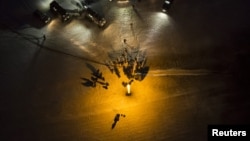MOSCOW —
Three crew members have returned to Earth from the International Space Station. The trio spent four months on the orbital station 250 miles above the Earth.
A Russian Soyuz capsule carrying U.S. astronaut Sunita Williams, Russian cosmonaut Yuri Malenchenko and Japanese astronaut Akhiko Hoshide parachuted to the snow-covered steppe in Kazakhstan. It was the first pre-dawn landing on the steppe in six years.
After being extracted from the capsule, the three smiled and appeared relaxed on Russian state television.
The crew spent 125 days on the International Space Station conducting numerous experiments, including tests on radiation levels at the orbiting complex. They also researched the effects of melting glaciers and seasonal changes on Earth’s ecosystems, according to the U.S. space agency NASA.
During the crew’s time in space, a broken cable in Moscow caused Russian Mission Control to lose contact with the station on November 14.
Russian space agency chief Vladimir Popovkin said the break in communications did not affect the space station.
Popovkin said Russian and U.S. mission-control centers can fully substitute for each other, and Russia had no problems forwarding control of the space station to the Americans in Houston. As for Russia's satellite network, he said some reserve systems were used, and there was no loss of communication.
Russia's space agency has had a number of recent setbacks. Last year, the Phobos-Grunt probe, meant to collect soil from Mars and return to Earth, blasted off from the Baikonour Cosmodrome in Kazakhstan but failed to leave orbit. In another incident, a Soyuz rocket carrying cargo bound for the space station failed to reach orbit and crashed in Siberia.
Many analysts say the mishaps are partly due to a decrease in the country’s space budget.
Russia has been the only country ferrying crew members to the International Space Station since NASA retired its shuttle fleet 16 months ago. As a result, the United States pays Russia about $60 million to send an astronaut to the space station.
A Russian Soyuz capsule carrying U.S. astronaut Sunita Williams, Russian cosmonaut Yuri Malenchenko and Japanese astronaut Akhiko Hoshide parachuted to the snow-covered steppe in Kazakhstan. It was the first pre-dawn landing on the steppe in six years.
After being extracted from the capsule, the three smiled and appeared relaxed on Russian state television.
The crew spent 125 days on the International Space Station conducting numerous experiments, including tests on radiation levels at the orbiting complex. They also researched the effects of melting glaciers and seasonal changes on Earth’s ecosystems, according to the U.S. space agency NASA.
During the crew’s time in space, a broken cable in Moscow caused Russian Mission Control to lose contact with the station on November 14.
Russian space agency chief Vladimir Popovkin said the break in communications did not affect the space station.
Popovkin said Russian and U.S. mission-control centers can fully substitute for each other, and Russia had no problems forwarding control of the space station to the Americans in Houston. As for Russia's satellite network, he said some reserve systems were used, and there was no loss of communication.
Russia's space agency has had a number of recent setbacks. Last year, the Phobos-Grunt probe, meant to collect soil from Mars and return to Earth, blasted off from the Baikonour Cosmodrome in Kazakhstan but failed to leave orbit. In another incident, a Soyuz rocket carrying cargo bound for the space station failed to reach orbit and crashed in Siberia.
Many analysts say the mishaps are partly due to a decrease in the country’s space budget.
Russia has been the only country ferrying crew members to the International Space Station since NASA retired its shuttle fleet 16 months ago. As a result, the United States pays Russia about $60 million to send an astronaut to the space station.







